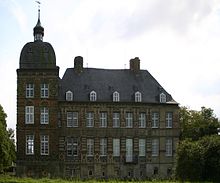Lippe Renaissance
The term Lipperenaissance describes a Nordic variant of the Renaissance .
The name for a small group of buildings goes back to Richard Klapheck , who first spoke of a "Lippe School". Later, the name Lipperenaissance established itself analogously to comparable names such as the Weser Renaissance (it too ultimately goes back to Klapheck). The main feature of the Lippe Renaissance is an oversized fitting decoration that covers the external facades of the buildings. It is made up of circles, semicircles, diamonds and squares that are connected by ribbons to form a kind of network. The historical context is perhaps more aptly described by the term "Horster Bauschule", also used by Klapheck, because the forms, which were based on Dutch ideas, found their way into the region via Horst Castle.
The castle buildings of the master builder Laurenz von Brachum , which are almost without exception in the eponymous valley of the Lippe, are counted as part of the Lippe Renaissance. These include:
- Horst Castle (1554–1572) in Gelsenkirchen
- House Assen (1564) in Lippetal
- Crassenstein Castle (1570) in Wadersloh - Diestedde
- Haus Geist (1560) near Oelde
- Hovestadt Castle (1563–1572) in Lippetal- Hovestadt
- House Nehlen (1631) in Welver -Berwicke
- Overhagen Castle (1619), the construction is by Laurenz von Brachum the Younger
Urban houses with this decor are rare, including the house Roggenmarkt 12 in Münster . The gable of the Wulferthaus at Neuer Markt 2 in Herford , which was built around 1577/78, also has typical Lippe Renaissance décor . The painted wooden ceiling of the hall in the cathedral courtyard in Rheda also shows these forms. However, it was not created until 1663.
literature
- Klaus Gorzny: Lippe locks. Castles, palaces and aristocratic residences along the Lippe. A companion . Piccolo, Marl 2004, ISBN 3-9801776-8-8 , pp. 19-21.

